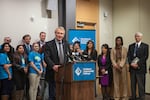The idea for OPB’s Class of 2025 project came after the state set an ambitious goal: to achieve 100% high school graduation by 2025.
That’s two years away, and at 81.3%, Oregon is far from meeting the goal. But it’s not clear anyone is noticing. The goal no longer seems to be top of mind for Oregon’s top leaders.
In 2011, the state legislature enacted a law to make “40-40-20″ the mission for “all education beyond high school” for the state: that at least 40% of Oregonians would have a Bachelor’s degree or higher, that another 40% would have an associates’ or post-secondary credential of some kind, and that the remaining 20% would have a high school diploma or equivalent.
40+40+20 equals 100. 100% of adult Oregonians with at least a high school diploma or equivalent by 2025.

Third graders at Earl Boyles Elementary School play recorders at a winter concert, Dec. 18.
Jason Bernhert / OPB
It’s hard to know if Oregon leaders still feel as committed to that goal as they did in 2011. John Kitzhaber, the governor who first announced that goal at his inaugural speech in January 2011, resigned from office in February 2015. Oregon’s new governor, Tina Kotek, announced a different graduation rate goal when she was running for office: to improve Oregon’s graduation rate to “90% for all student groups by 2027.” That’s 10% lower, two years later.
As Oregon’s political leadership has changed, so have the state’s priorities around education. 2025 is now less than two years away and as that date gets closer, the state’s focus on 100% graduation is receding. Instead, leaders are focused on new long-term goals directed at the state’s youngest children, not on the students that have been in school in the years since 40-40-20 was enacted.
But “40-40-20″ still remains a piece of legislation in Oregon, though it seems Oregon won’t make that goal by its self-imposed deadline.
40-40-20 by 2025
“We’re not gonna meet it,” said former Oregon Gov. John Kitzhaber in an interview with OPB about the education goal he launched amid a number of structural changes to the state’s education system.
Kitzhaber first mentioned 40-40-20 in his 2011 inaugural address as part of a three-point plan. He called 40-40-20 a vision.
“We need to know where we are going,” he said in 2011. “We need a destination.”
Twelve years later, Oregon has not reached that destination. According to the latest figures from the Higher Education Coordinating Commission, in 2019, 39% of Oregonians had a Bachelor’s degree, 19% had an Associate’s or two-year degree, and 39% had graduated high school or received a GED. 7% of Oregonians had “less than high school”.
Shortly after being reelected for a fourth term, Kitzhaber became embroiled in an influence-peddling scandal and resigned under pressure in February 2015. With Kitzhaber out and Gov. Kate Brown in place, some of the mechanisms Kitzhaber created to achieve 40-40-20 fell away. That included the Oregon Education Investment Board, a group of education and business professionals tasked with building a better bridge from K-12 and postsecondary education to the workforce.
“I think the vision is still there but the tools to make it happen are no longer there,” he said.

Gov. John Kitzhaber speaks at Portland Community College Rock Creek Campus, on Tuesday, March 14, 2014. Kitzhaber signed two bills at the college, designed to help more low-income students achieve a higher education credential.
Katelyn Brown / OPB
He said there are other things getting in the way of the 40-40-20 vision as well, like the politics and lack of institutional memory in Salem.
“We have such a big turnover in the legislature that I would say very few people down there actually remember why we did 40-40-20,” he said.
Between legislative turnover and constant fighting between the two major parties, Kitzhaber said the long-term planning that needs to happen to meet goals like 40-40-20 is impossible.
“It’s like a traveling Broadway show where the only thing that matters is what happens inside the tent, not what’s going on outside … to some extent, the only thing that connects one session to another is this increasingly toxic political campaign.”
Kitzhaber adds that the pandemic has also kept the state from reaching its goal.
Moving forward, Kitzhaber said the state needs to figure out how the state’s education budget actually helps kids. The biggest piece of the state’s general fund goes to schools.
“The K-12 number drives the budget debate in Salem, it did in 1979, and it still does today,” he said. “It is a number without a context. They take what we spent last year, and roll it up, and never asked, ‘Is the way we spent money last year getting us where we want to go?’”
Kitzhaber also thinks Oregon needs to re-create a board similar to the OEIB, where folks from the education and business worlds can talk about the pathways from education into the workforce.
But that’s not on the list of priorities for the current leaders in Salem.
90% by 2027
Graduation rates and Oregon’s requirements for graduation were one part of the conversation as candidates for governor campaigned last fall.
During two separate gubernatorial debates, candidate Tina Kotek, former speaker of the Oregon House, spoke about graduation.
“What’s important for me is setting high standards and high expectations for all Oregon students,” Kotek said during an October 6 debate.
At a September 27 debate in Bend, Kotek referenced the graduation rate goal on her campaign website.
“You’ll see on my website, I call for increasing our graduation rates over the next four to five years so more students are graduating and have a pathway.”
That call, which is now listed on Gov. Tina Kotek’s website at the top of her list of education priorities is to “improve Oregon’s graduation rates to 90% for all student groups by 2027.”
With Oregon’s statewide graduation rate at 81.3%, it might be more realistic to believe Oregon could reach that number in four years, compared to reaching 100% in two years.
But Carla Gay wants to know more about that 90% goal, and what it means for all of Oregon’s students. Gay, executive director of innovation and partnerships at Gresham-Barlow School District and advisory board member of the Grad Partnership, said 90% could be a benchmark, but not an end goal.
“40-40-20 was really about 100% of our K-12 students having a high school diploma or GED,” she said.
“If we lose sight of 100% of our students need to complete high school with a diploma or a GED, and we settle for anything less than that, then once again, we let ourselves off the hook and my question would be: Which 10% are we not going to graduate? How are we deciding that?”
Gov. Kotek was unavailable for an interview with OPB to talk about her 90% graduation goal. In response to questions about whether her goal replaces 40-40-20, a representative from her office responded by sharing the Governor’s three education-related goals for her first year: early literacy, child care infrastructure, and “ensuring that all Oregon students are better served by our K-12 schools.”
“These strategies will help students and school systems recover from the learning loss that occurred during the pandemic and ultimately improve metrics like graduation rates and reading and writing proficiency,” read the message shared by Kotek’s press secretary Anca Matica.

Then-Oregon Gov.-elect Tina Kotek, center, is swarmed by third-graders from Arleta School following Kotek’s press conference on Nov. 10, 2022 at the Salmon Street Springs in Portland.
Kristyna Wentz-Graff / OPB
The Governor’s office did not address a question about specific ideas to help student groups reach 90%.
“It’s important to have targets,” said Oregon Sen. Michael Dembrow in response to questions about 40-40-20 and the 90% by 2027 goals. Dembrow is a former Portland Community College instructor and chair of the Senate education committee.
“I would say that the actual targets themselves are less important than our steady progress (or not) at reaching them.”
And Oregon has made steady progress in the last 10 years, with a 14.9 percentage point increase in graduation rates since 2011. According to a June 2023 report from the Everyone Graduates Center at Johns Hopkins University, while Oregon remains in the bottom half of states when it comes to graduation rates, the percentage point change in graduation rate from 2011 to 2020 was the sixth best in the country.
Oregon Department of Education officials highlight the state’s ongoing commitment to improving graduation rates through the state’s High School Success fund, which provides money to school districts.
But as we get closer to 2025, Oregon’s education priorities are shifting away from the end of high school and more towards the first few years of public education.
“Outcomes are hard to move if you don’t really understand where they came from”
There are many ways to know if a student is at risk of not graduating even before they get to 12th grade, including whether a student has been attending regularly, or has earned at least a quarter of the required credits to graduate by the end of ninth grade. But some indicators may be present even earlier.
Some researchers have discovered that behavior or failing grades in middle school may be a sign. One study found that third-grade reading proficiency could also signal whether a student might graduate, in addition to other socioeconomic factors.
These findings align with the bigger shift in education priorities in Oregon and nationally. Both reading and child care are fundamental to a child’s success in school.
“Graduation rates are an outcome,” said Dan Farley, the Oregon Department of Education’s Assistant Superintendent of the Office of Research, Assessment, Data, Accountability, and Reporting.
“Outcomes are hard to move if you don’t really understand where they came from, or what is generating the outcomes.”
That means looking across a student’s educational experience — from early education to where students end up after high school, whether that’s college, the workforce, or somewhere else.

Students entering high school in fall 2021 are part of the Class of 2025.
Elizabeth Miller / OPB
Oregon’s new early literacy focus is on students in kindergarten through fifth grade. The results of that work should show up in graduation rates — but not for a while.
“It will absolutely lead to some increases in terms of literacy for that group of students, but we won’t see that investment show up in graduation rates for up to a decade for some of those students,” Farley said.
Former Gov. Kitzhaber’s professional focus has shifted earlier in a child’s experience, as well. Kitzhaber is a board member for the Oregon Health and Education Collaborative’s Upstream Initiative, a campaign focused on the first 1,000 days of a child’s life.
“That’s a piece we didn’t talk about in 2011,” Kitzhaber said.
“If you don’t begin to actually address the challenges that undermine kids and families at a very early age, that’s going to be reflected in their performance in education.”
But whatever goal Oregon is moving towards, Kitzhaber stresses the need for a process to get there.
“It’s good to have a goal,” he said.
“The question is, what are we going to do to achieve it? What are the budget and policy levers we’re going to use to achieve it?”
If you have questions or story ideas for the Class of 2025, reach out to Elizabeth Miller at emiller@opb.org.
